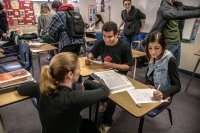How to Lead Students to Engage in Higher Order Thinking
Asking students a series of essential questions at the start of a course signals that deep engagement is a requirement.
Your content has been saved!
Go to My Saved Content.I teach multigrade, theme-based courses like Spirituality in Literature and The Natural World in Literature to high school sophomores, juniors, and seniors. And like most English language arts teachers, I’ve taught courses built around the organizing principles of genre (Introduction to Drama), time period and geography (American Literature From 1950), and even assessment instrument (A.P. Literature).
No matter what conceptual framework guides the course I’m teaching, though, I begin and anchor it with what I call a thinking inventory.
Thinking Inventories and Essential Questions
Essential questions—a staple of project-based learning—call on students’ higher order thinking and connect their lived experience with important texts and ideas. A thinking inventory is a carefully curated set of about 10 essential questions of various types, and completing one the first thing I ask students to do in every course I teach.
Although a thinking inventory is made up of questions, it’s more than a questionnaire. When we say we’re “taking inventory”—whether we’re in a warehouse or a relationship—we mean we’re taking stock of where things stand at a given moment in time, with the understanding that those things are fluid and provisional. With a thinking inventory, we’re taking stock of students’ thinking, experiences, and sense-making at the beginning of the course.
A well-designed thinking inventory formalizes the essential questions of any course and serves as a touchpoint for both teacher and students throughout that course. For a teacher, writing a course’s thinking inventory can help separate the essential from the nonessential when planning. And starting your class with a thinking inventory signals to students that higher order thinking is both required and valued.
How to Design an Effective Thinking Inventory
I tell students the thinking inventory is a document we’ll be living with—revisiting and referring to often—and that they should spend time mulling their answers before writing them down. The inventory should include a variety of essential questions, including ones that invite students to share relevant experiences.
I may ask students about their current knowledge base or life experience (What’s the best example of empathy you’ve ever witnessed?). I may ask them to make predictions or imagine scenarios (How will an American Literature course in 100 years look different from today’s American Literature course?). Or I may ask perennial questions (To what extent is it possible for human beings to change fundamentally?).
Here are a few of the questions I asked students to address at the start of a course called The Outsider in Literature:
- Who is the most visionary person you know? How do you know they’re visionary? Is there anything about them you want to emulate? Anything about them that frightens you?
- What are the risks of rebelling? Of not rebelling? Explain.
- What would happen if there were no outsiders? How would the world, and your world, be different?
- Do you think there are any ongoing conflicts between groups that are intractable—that will likely never be resolved? What is the root of the intractability? What would need to happen in order to resolve the conflict? Be specific.
- Who is the most deviant, threatening outsider you can think of? Tell us what makes them threatening.
- To what extent do you think that teenagers, as a group, are (by definition) outsiders?
How I Use Thinking Inventories
On the first day of class, I give students the inventory for homework. Because I expect well-thought-out answers and generative thinking, I assign it in chunks over two nights, and we spend at least the second and third class meetings discussing their answers.
Throughout the course, I use the inventory both implicitly and explicitly. I purposefully weave inventory questions into discussions and student writing prompts. More explicitly, I use inventory questions as a framework for pre- and post-reading activities, and as prompts for reading responses, formal writing, and journaling.
The inventory functions as a kind of time stamp that documents each student’s habits of mind, opinions, and ways of framing experience at the start of the year or semester. At the midpoint and at the end of the course, I have students return to their inventory, choose a question they’d now answer differently, and reflect on why and how their thinking has changed.
The Inventory as a Bridge Between Students and Content
By including a variety of essential questions (practical and experiential, conceptual and theoretical) and making a course’s aims explicit, the inventory invites all students into the conversation and the material from day one. It gives a deep thinker with slower processing speed or attention-deficit/hyperactivity disorder, for example, time to orient themselves to the course’s core questions. Meanwhile, the inventory challenges students who see themselves as high achievers to respond authentically to thorny questions that have no right answers.
In addition, using a thinking inventory models how to ask good questions; gives introverts and anxious students an entry point because cold calling becomes warmer (I can ask, “What did you say on your inventory?”); and cultivates a community of learners connected by real, worthwhile inquiry and communal discourse.
Recently, a student reflecting on his inventory at the end of a course wrote that he was taken aback by how intolerant of “loser characters” he’d seemed just a few months prior on his inventory. He noted that he’d been through some upheaval since then. And he ended his paper with the observation that empathy—for people and characters—grows “when you know their backstory.”
